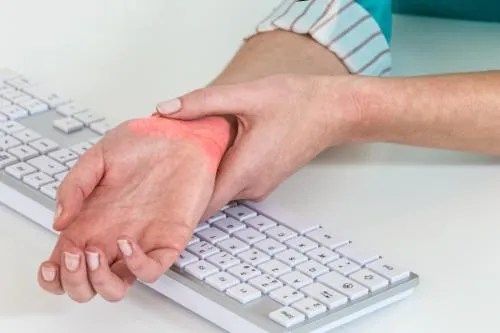
Chiropractic Care: An Effective Alternative for Carpal Tunnel Relief
Carpal tunnel syndrome (CTS) is a common condition characterized by pain, numbness, and tingling in the hand and fingers caused by compression of the median nerve as it travels through the wrist. An estimated 3-6% of the general population suffer from CTS, with women being three times more likely to be affected than men. The prevalence further increases in certain occupations requiring extensive repetitive hand motions such as typing, cashiering, or assembly line work. In this article, we’ll explore the benefits of chiropractic care and how it can help those that suffer from CTS.
Understanding Carpal Tunnel Syndrome
Carpal tunnel syndrome (CTS) is compression of the median nerve as it travels through the narrow carpal tunnel in the wrist. The carpal tunnel is formed by the small carpal bones of the wrist and the transverse carpal ligament which runs across the wrist. This rigid tunnel structure provides stability but also makes the median nerve vulnerable to compression.
The median nerve originates in the neck, runs down the arm and forearm, and enters the hand through the carpal tunnel. It provides sensation and movement to the thumb, index, middle and part of the ring finger. Any swelling or inflammation of the tendons and tissues surrounding the nerve within the carpal tunnel can put pressure on the nerve and cause CTS symptoms.
Common causes of CTS include repetitive hand motions that overwork the wrist such as prolonged typing, cashiering work, or assembling small parts. The repetitive friction leads to irritation and swelling of the tendons. Prior injuries such as fractures or sprains that cause wrist arthritis or alter carpal tunnel anatomy can also increase compression on the median nerve. Various medical conditions like hypothyroidism, rheumatoid arthritis and diabetes prompt fluid retention and inflammation that contribute to CTS. Pregnancy is another risk factor due to hormonal changes and fluid accumulation.
As the median nerve becomes increasingly compressed, CTS symptoms arise in a typical pattern beginning with pain, tingling, and numbness in the thumb, index and middle fingers. People may feel their fingers swelling at night. Symptoms often worsen with certain hand motions and grip activities. As CTS progresses, the pain can radiate up the arm, muscles at the base of the thumb may atrophy, and loss of hand coordination and grip strength can occur. Prompt treatment is key to relieving symptoms and restoring wrist and hand function.
Chiropractic Care: A Holistic Solution for Carpal Tunnel Syndrome
Chiropractic takes a whole-body, holistic approach to addressing carpal tunnel syndrome (CTS) that goes beyond just managing the symptoms. Chiropractors focus on locating and correcting underlying spinal and limb misalignments or subluxations that can cause biomechanical imbalances, abnormal nerve signaling, and inflammation associated with CTS.
The neck and thoracic spine have a key connection to the nerves and musculoskeletal structures of the arms and hands. Poor neck posture or intervertebral joint dysfunctions in the upper back can irritate the nerves originating in the cervical and thoracic spine that eventually form the median nerve running through the carpal tunnel. Chiropractic adjustments help realign the vertebrae, decompress nerve roots, and restore optimal nerve function.
Additionally, chiropractors examine the interconnected network of joints, muscles, and soft tissues spanning from the wrist up through the forearm, elbow, shoulder and neck. Through chiropractic manipulations, they can relieve stiffness and improve range of motion in the joints of the arms and wrist to take pressure off the median nerve. Gentle tissue mobilization techniques loosen tight muscles and adhesions around the carpal tunnel.
Chiropractors may also prescribe rehabilitative stretches and exercises focused on posture correction, strength training, and balancing the wrist and forearm muscles. Custom orthotics or ergonomic advice can help optimize biomechanics for the patient’s activities. This multifactorial approach addresses the root causes behind median nerve compression to provide sustained relief.
Rather than just masking symptoms with medication or injections, chiropractic care aims to keep the musculoskeletal and nervous systems working harmoniously to prevent future recurrence of CTS. Studies confirm chiropractic’s benefits, showing significant improvement in hand pain, grip strength, and function in CTS patients undergoing chiropractic treatment. As a drug-free, non-surgical solution, chiropractic represents an effective long-term approach to managing CTS.
Benefits of Chiropractic Care for Carpal Tunnel Syndrome
1. Targeted Spinal Adjustments – Chiropractors perform specific manipulations called adjustments to realign vertebrae in the cervical and thoracic spine. Misalignments in these areas can irritate nerves that form the median nerve running through the carpal tunnel. By restoring proper alignment, nerve tension is decreased. Chiropractic adjustment techniques use controlled force to mobilize joints and take pressure off compressed nerves, providing fast relief for CTS symptoms.
2. Wrist and Hand Joint Mobilization – Gentle, graded joint manipulation techniques help improve range of motion in the carpal bones of the wrist as well as joints in the hands and fingers. Increased mobility helps open up the carpal tunnel space and takes tension off the median nerve. Mobilization also increases synovial fluid circulation to reduce inflammation within the tunnel.
3. Myofascial Release – Chiropractors use gentle sustained pressure to relax the connective tissue and muscles surrounding the carpal tunnel. This helps break up adhesions between the skin, muscles and carpal ligament to reduce compression on the median nerve. Myofascial release improves overall circulation and nerve glide ability.
4. Posture Correction and Ergonomic Modifications – Chiropractors assess spine, shoulder and neck posture that can contribute to poor positioning of the wrist and exacerbate CTS. Exercises and stretching focused on posture correction along with custom orthotics help re-align the upper body. Advice on ergonomic equipment, proper wrist positions during activities, and workplace modifications also help reduce nerve compression forces.
5. **Rehabilitation Exercises – Chiropractors design specific exercise programs to strengthen muscles and stabilize joints from the neck down to the hand. Stretches and movements help balance muscle groups across the wrist, forearm, elbow and shoulder. This comprehensive exercise therapy aids recovery and prevents future flare ups of CTS symptoms.
Chiropractic Care – An Effective Solution for Managing Carpal Tunnel Syndrome
Carpal tunnel syndrome (CTS) is a complex condition with multiple contributing factors. While conventional treatments like NSAIDs, steroid injections and surgery can provide temporary symptom relief, they fail to address the root biomechanical causes of CTS. This often leads to recurrence of symptoms and progression of median nerve damage.
Chiropractic care takes a more holistic, whole-body approach to treating CTS by identifying and correcting spinal misalignments, joint restrictions, muscle imbalances, and posture issues from the neck down to the hand. Chiropractic adjustments alleviate nerve compression while joint mobilization and soft tissue techniques reduce inflammation and tension around the median nerve. Combined with rehabilitative exercises, ergonomic modifications and patient education, chiropractic provides an effective solution for managing CTS.
Numerous studies validate the benefits of chiropractic care for CTS patients. Not only does chiropractic lead to significant reduction in hand pain, numbness, and tingling, but also restores grip strength, dexterity and function. Patients show sustained improvement without the adverse effects of medication or the risks of surgery.
If you or a loved one suffers from debilitating CTS symptoms, don’t despair. Take control of your health and consider chiropractic care to address the root causes of this condition, rather than just temporarily numbing the pain. With the multidimensional protocols and holistic perspective of chiropractic, it is possible to keep CTS from dictating your life. Contact our office today to schedule a comprehensive evaluation and personalized treatment plan to effectively manage your CTS.
This article is copyrighted by Blogging Chiropractors for its Doctor of Chiropractic members and may not be copied or duplicated in any manner including printed or electronic media, regardless of whether for a fee or gratis without the prior written permission of Blogging Chiropractors.
Office Hours
Mon 8:00-12:30, 2:30-7pm
Tues 8:00-12:30, 2:30-7pm
Wed 8:00-12:30, 2:30-7pm
Thurs 8:00-12:30, 2:30-7pm
Fri - Sun Closed
© 2025 Gonstead Chiropractic Center - All Rights Reserved


